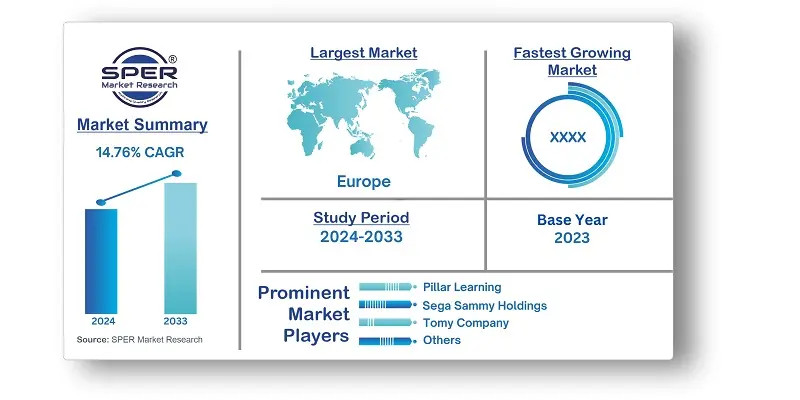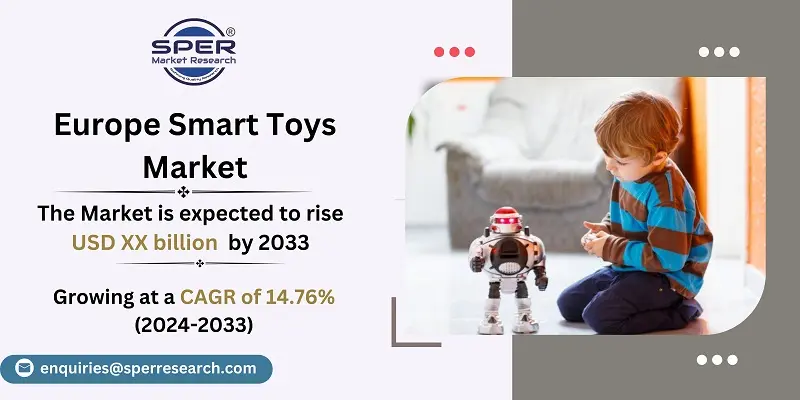
Europe Smart Toys Market Growth, Size, Trends, Demand, Revenue, Share and Future Outlook
Europe Smart Toys Market Size- By Type, By Technology, By Distribution Channel- Regional Outlook, Competitive Strategies and Segment Forecast to 2033
| Published: Mar-2024 | Report ID: FMCG2478 | Pages: 1 - 158 | Formats*: |
| Category : Consumer & Retail | |||
- November 2017: Hasbro Inc. and Mattel Inc. partnered to provide Barbie with robotics engineering facilities. With the use of artificial intelligence (AI), this robot can teach children six free coding classes, fostering their intellectual development.


| Report Metric | Details |
| Market size available for years | 2020-2033 |
| Base year considered | 2023 |
| Forecast period | 2024-2033 |
| Segments covered | By Type, By Technology, By Distribution Channel |
| Regions covered | Germany, France, Italy, Spain, UK, Rest of Europe |
| Companies Covered | Geobra Brandstätter Stiftung & Co. KG, Hasbro, Inc., Konami Holdings Corporation, LEGO Group (KIRKBI A/S), Mattel, Inc., Pillar Learning, Primo toys, Sega Sammy Holdings, Inc. (Sega Toys Co., Ltd.), Tomy Company, Ltd., VTech Holdings Limited, Others. |
- Parents and Caregivers
- Children and Adolescents
- Educational Institutions and Teachers
- Retailers and Distributors
- Toy Manufacturers and Developers
| By Type: |
|
| By Technology: |
|
| By Distribution Channel: |
|
- Europe Smart Toys Market Size (FY’2024-FY’2033)
- Overview of Europe Smart Toys Market
- Segmentation of Europe Smart Toys Market By Type (Robots, Interactive Games, Educational Robots)
- Segmentation of Europe Smart Toys Market By Technology (Wi Fi, Bluetooth, RFID or NFC, Others)
- Segmentation of Europe Smart Toys Market By Distribution Channel (Offline Retail Stores, Online)
- Expansion Analysis of Europe Smart Toys Market
- Problems and Obstacles in Europe Smart Toys Market
- Competitive Landscape in the Europe Smart Toys Market
- Impact of COVID-19 and Demonetization on Europe Smart Toys Market
- Details on Current Investment in Europe Smart Toys Market
- Competitive Analysis of Europe Smart Toys Market
- Prominent Players in the Europe Smart Toys Market
- SWOT Analysis of Europe Smart Toys Market
- Europe Smart Toys Market Future Outlook and Projections (FY’2024-FY’2033)
- Recommendations from Analyst
1.1. Scope of the report1.2. Market segment analysis
2.1. Research data source2.1.1. Secondary Data2.1.2. Primary Data2.1.3. SPER’s internal database2.1.4. Premium insight from KOL’s2.2. Market size estimation2.2.1. Top-down and Bottom-up approach2.3. Data triangulation
4.1. Driver, Restraint, Opportunity and Challenges analysis4.1.1. Drivers4.1.2. Restraints4.1.3. Opportunities4.1.4. Challenges4.2. COVID-19 Impacts of the Europe Smart Toys Market
5.1. SWOT Analysis5.1.1. Strengths5.1.2. Weaknesses5.1.3. Opportunities5.1.4. Threats5.2. PESTEL Analysis5.2.1. Political Landscape5.2.2. Economic Landscape5.2.3. Social Landscape5.2.4. Technological Landscape5.2.5. Environmental Landscape5.2.6. Legal Landscape5.3. PORTER’s Five Forces5.3.1. Bargaining power of suppliers5.3.2. Bargaining power of buyers5.3.3. Threat of Substitute5.3.4. Threat of new entrant5.3.5. Competitive rivalry5.4. Heat Map Analysis
6.1. Europe Smart Toys Market Manufacturing Base Distribution, Sales Area, Product Type6.2. Mergers & Acquisitions, Partnerships, Product Launch, and Collaboration in Europe Smart Toys Market
7.1. Europe Smart Toys Market Value Share and Forecast, By Type, 2024-20337.2. Robots7.3. Interactive Games7.4. Educational Robots
8.1. Europe Smart Toys Market Value Share and Forecast, By Technology, 2024-20338.2. Wi Fi8.3. Bluetooth8.4. RFID or NFC8.5. Other
9.1. Europe Smart Toys Market Value Share and Forecast, By Distribution Channel, 2024-20339.2. Offline Retail Stores9.3. Online
10.1. Europe Smart Toys Market Size and Market Share
11.1. Europe Smart Toys Market Size and Market Share By Type (2020-2026)11.2. Europe Smart Toys Market Size and Market Share By Type (2027-2033)
12.1. Europe Smart Toys Market Size and Market Share By Distribution Channel (2020-2026)12.2. Europe Smart Toys Market Size and Market Share By Distribution Channel (2027-2033)
13.1. Germany13.2. France13.3. Italy13.4. Spain13.5. UK13.6. Rest of Europe
14.1. Geobra Brandstätter Stiftung & Co. KG14.1.1. Company details14.1.2. Financial outlook14.1.3. Product summary14.1.4. Recent developments14.2. Hasbro, Inc.14.2.1. Company details14.2.2. Financial outlook14.2.3. Product summary14.2.4. Recent developments14.3. Konami Holdings Corporation14.3.1. Company details14.3.2. Financial outlook14.3.3. Product summary14.3.4. Recent developments14.4. LEGO Group (KIRKBI A/S)14.4.1. Company details14.4.2. Financial outlook14.4.3. Product summary14.4.4. Recent developments14.5. Mattel, Inc.14.5.1. Company details14.5.2. Financial outlook14.5.3. Product summary14.5.4. Recent developments14.6. Pillar Learning14.6.1. Company details14.6.2. Financial outlook14.6.3. Product summary14.6.4. Recent developments14.7. Primo toys14.7.1. Company details14.7.2. Financial outlook14.7.3. Product summary14.7.4. Recent developments14.8. Sega Sammy Holdings, Inc. (Sega Toys Co., Ltd.)14.8.1. Company details14.8.2. Financial outlook14.8.3. Product summary14.8.4. Recent developments14.9. Tomy Company, Ltd.14.9.1. Company details14.9.2. Financial outlook14.9.3. Product summary14.9.4. Recent developments14.10. VTech Holdings Limited14.10.1. Company details14.10.2. Financial outlook14.10.3. Product summary14.10.4. Recent developments14.11. Others
SPER Market Research’s methodology uses great emphasis on primary research to ensure that the market intelligence insights are up to date, reliable and accurate. Primary interviews are done with players involved in each phase of a supply chain to analyze the market forecasting. The secondary research method is used to help you fully understand how the future markets and the spending patterns look likes.
The report is based on in-depth qualitative and quantitative analysis of the Product Market. The quantitative analysis involves the application of various projection and sampling techniques. The qualitative analysis involves primary interviews, surveys, and vendor briefings. The data gathered as a result of these processes are validated through experts opinion. Our research methodology entails an ideal mixture of primary and secondary initiatives.



Frequently Asked Questions About This Report
PLACE AN ORDER
Year End Discount
Sample Report
Pre-Purchase Inquiry
NEED CUSTOMIZATION?
Request CustomizationCALL OR EMAIL US
100% Secure Payment






Related Reports
Our Global Clients
Our data-driven insights have influenced the strategy of 200+ reputed companies across the globe.




















